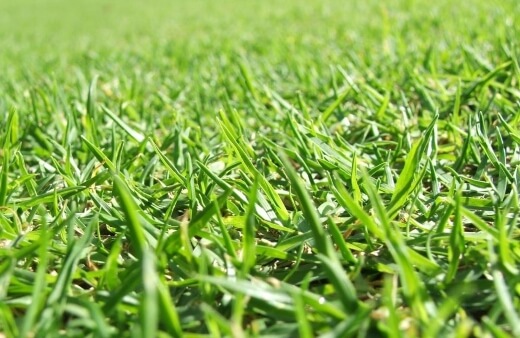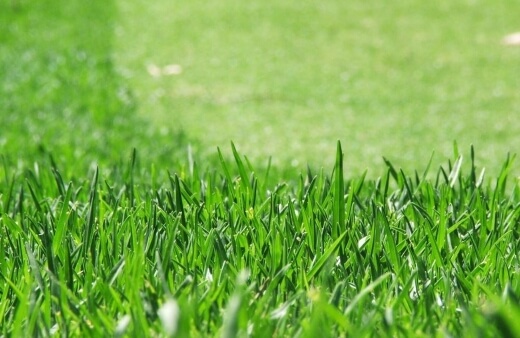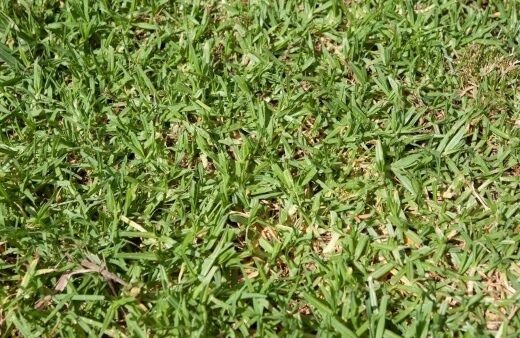Picking the right type of grass can be challenging with so many options available and a range of environmental and growth conditions. Kikuyu grass has become a popular option for Australian gardens due to its aggressive growth rate and impressive adaptability to a range of conditions.
This lawn variety is a fantastic, economic all-rounder ideal for gardens, patchy lawns, larger spaces and even areas designed for livestock, it's also one of the best grasses for dogs. Here is everything you need to know to cultivate, care for and grow Kikuyu .
More...
What is Kikuyu Grass?

Kikuyu is an interesting lawn alternative known as one of the hardiest and most cost-effective options for gardens and larger areas.
Kikuyu grass, Pennisetum clandestinum, is part of the Poaceae family and had been imported from the Belgian Congo. This well-known African grass increased in popularity, originally being used for golfing terrains.
Traditionally, Kikuyu was not only a trusted lawn alternative. Kikuyu is also believed to have medicinal benefits once crushed up and applied to wounds.
The juices of the grass have clotting qualities that can reduce excessive bleeding. Throughout Australia, however, Kikuyu is used for a range of landscapes.
It’s a great choice to replace struggling, patchy lawns or areas which experience excessive foot traffic from pets or children. It’s also a great choice for livestock grazing, known to be packed with plenty of vitamins and minerals.
It is also a particularly green, soft and dense-growing grass that offers an expensive-looking uniform appeal. However, you choose to grow Kikuyu grass; this incredible grass is relatively easy to establish and, once established, grows easily and happily.
(Here is our list of grass types in Australia)
Key Characteristics of Kikuyu Grass
There are a lot of benefits to growing Kikuyu grass and a few shortfalls. As long as you’re growing your Kikuyu in a full sun spot, it’ll grow vigorously and thrive.
Advantages
- Kikuyu grass has strong, deep roots, which makes it incredibly resilient.
- This variety of grass repairs incredibly quickly, ideal for areas with lots of foot traffic. Great for gardens with children or pets.
- This grass is incredibly drought tolerant, needing little supplementary water – making it very economical.
- The deep roots also make it great for erosion control.
- When supported with fertiliser, Kikuyu grass produces an ocean of bright green – becoming the envy of your neighbours.
Disadvantages
- Kikuyu grass tends to turn yellowish during the winter, which some growers don’t like.
- It’s an incredibly aggressive grower, so in certain regions, it can become invasive and affect other plants.
- Kikuyu is not shade tolerant and will die off quickly when not receiving sufficient daily sunlight.
Refer to our compilation of shade tolerant grasses to see if they might be a better match for your location.
How to Grow Kikuyu Grass

Kikuyu grass is relatively easy to establish and can be grown from seed, cutting or from ready-made turf. Although it takes a little time to really get going, especially when growing from seed, once established, it grows incredibly quickly.
Most often, Kikuyu doesn’t enjoy growing in overly saline soils. However, in well-draining, fertile soils, it shouldn’t have an issue.
Growing Kikuyu Grass from Turf
When growing from turf, it’s essential to plant your grass as soon as possible after purchasing as the rhizomes can dry out quickly and become damaged. Before planting, be sure to use a quality turf underlay that will allow the grass to grow effectively.


Get Your Free Guide:
Master Growing Australian Natives eBook
A Must Have Complete Guide for Every Australian Garden
Get Your Free Guide:
Master Growing Australian Natives eBook
A Must Have Complete Guide for Every Australian Garden
Soak your turf thoroughly every day for the first 10 to 14 days after installation. This will ensure the establishment of roots and keep your grass looking greener for longer.
Growing Kikuyu From Seed
Growing Kikuyu grass from seed is done as with any kind of traditional grass. In general, it’s a good idea to use 10 to 12 grams of seed per 1 square metre for optimal results. Once sown, it’s essential to keep your seeds well-watered in order for them to sprout.
Germination generally takes anywhere between 10 to 14 days. Growing from seed can be slow to start but once established, it will thrive.
Propagating Kikuyu from Cutting
Another method of propagation for Kikuyu is to simply remove a cutting, dig out some rhizomes and replant them into your desired areas.
Rhizomes should be dug up during the spring for optimal results. After replanting, it’s essential to water often.
Kikuyu Grass Care Tips
Once your grass is established, it really won’t require too much more care than your average lawn- if not less. The most important feature of care will be to make sure it’s well watered in the beginning and regular mowing once established.
Watering Kikuyu

Kikuyu grass is all about efficient irrigation. In the beginning, it’s a good idea to regularly soak the grass and keep the soil wet. However, once established, you’ll only need to water it when the grass looks dry.
(Find out which is the best water to use for plants in Australia here.)
Watering in the early morning is recommended; around 30 minutes with a sprinkler should sufficiently soak the soil and keep your grass healthy. Avoid watering in the cold or during the winter as it can encourage the soil to be yellow quicker. Only water if the grass is looking incredibly dry and wilted.
Check out our in-depth guide for choosing the best lawn sprinklers to help you choose the best setup for your garden.
Fertilising Kikuyu Grass
This kind of grass responds very well to regular fertilising and will ensure plenty of brilliantly green leaves. A general, slow-release fertiliser is always a good option.
It is important to note that Kikuyu grass responds particularly well to nitrogen. As such, it’s recommended to choose a fertiliser that is high in nitrogen.
Ideal fertilising times are in late spring, late summer and late autumn for the best results. Ensure you thoroughly water your lawn after fertilising.
Mowing Kikuyu Grass

As this is such a vigorous grower, frequent mowing will be required during the summer. It is advisable to mow between 2 to 5 cm every 7 to 10 days, on average.
When mowing, it’s essential to use a mower with sharp blades so as not to damage too much of the grass. (If you don't have one yet, here is our list of best electric lawn mowers available in Australia.)
Never leave less than a 1/3 of the grass stalks to ensure grass recovers and grows back even better. Winter mowing may not be necessary, but you can mow on average every 4 to 6 weeks.
Potential Kikuyu Grass Pest and Weed Problems
As with any kind of lawn, weeds can become a pressing issue, especially when they start to take over your lawn. Luckily, due to its dense growth habit, it can be harder for weeds to spread as opposed to other grass varieties.
More so, this kind of lawn is resilient and tolerates most domestic weed killers. Before grabbing a weed-killer, consider trying to remove weeds by hand first or you can check out our review on the best weed killers available in Australia.
Either way, it’s always a good idea to check the label before applying any chemical-based solution to your lawn to ensure it’s safe. Kikuyu grass is generally quite hardy when it comes to critters and pests.
However, when under duress, an issue with lawn grubs and beetles can occur. Common examples are army worms and African Black Beetles. Pests can easily be kept under control with an organic pesticide.
Kikuyu Grass FAQs

How do you identify Kikuyu Grass?
To identify Kikuyu grass, it’s a good idea to take a look at the leaves. Kikuyu grass has thin, flat leaf blades with a pointed leaf tip. Leaves usually range in height between 70 to 150 mm.
How can I thicken my Kikuyu Grass?
There are a few ways you can ensure a luscious growing lawn. Be sure to cut the grass shorter and more often during rainy seasons. In extreme heat, avoid mowing your lawn and allowing it to grow slightly more (this will protect the soil).
Weed regularly and support growth with a good amount of fertiliser.
How many types of Kikuyu Grass are there?
There are common varieties of Kikuyu grass, being Zulu Kikuyu and Green Kikuyu.
When should I plant Kikuyu Grass?
The best time to plant your grass is during the spring, summer or autumn. This way, the roots can establish themselves before the cold of the winter.
Will Kikuyu grow in winter?
The ideal growing season for Kikuyu grass is during the summer when it’s warm and humid. During the colder months, Kikuyu grass does go into a slight dormancy and will stop growing as quickly as it would in the summer.
Why is my Kikuyu grass dying?
Yellowing and drying grass can be a sign of a deeper issue. Most often, if this issue arises in warm weather, it can be a sign of Kikuyu yellows disease. This is a fungal infection that damages the root system.
Are you looking for other options? Take a look at our lawn alternatives guide here.
Start Growing Kikuyu Grass in Your Lawn!
Now you have all the information you need to start growing this incredible lawn alternative. If we’re honest, most gardeners want gloriously green carpets of green across their garden, and Kikuyu grass makes having a gorgeously green garden even easier.

Published on January 4, 2022 by Gary Clarke
Last Updated on September 20, 2025




